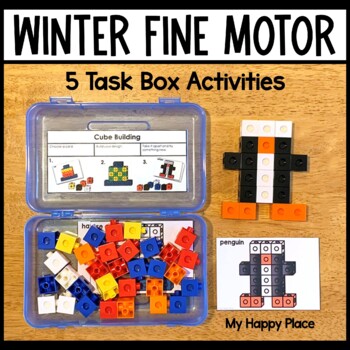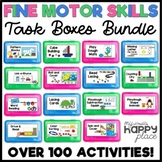Winter Fine Motor Skills Task Boxes
- PDF
What educators are saying
Also included in
- This bundle of over 100 fine motor activities targets the development of fine motor skills in preschool and kindergarten students while also fostering independence and excitement about school. Fine motor skills in young children are a predictor of academic success, but many students begin school stPrice $53.00Original Price $106.75Save $53.75
Description
This fine motor task boxes set includes 5 engaging winter activities designed to help your students build fine motor skills while practicing academic concepts. Perfect for morning tubs, early finishers, centers, or busy boxes, this set of activities targets the development of fine motor skills in preschool and kindergarten students while also fostering independence and excitement about school. Designed to be completed independently, these fine motor activities build finger strength, dexterity, and coordination while giving you time to take care of some of the many other tasks that demand your attention each day!
These activities are part of the Fine Motor Skills Task Boxes Bundle.
These Winter Fine Motor Task Boxes Include:
This set includes ideas and printable materials for 5 fine motor activities. Each task is designed to fit into a standard plastic pencil box and includes a printable label, picture directions, and other materials (such as work mats or task cards). The tasks in this set target preschool and kindergarten literacy and math concepts.
The included fine motor activities are:
▶ Winter Roll and Cover (1 die or 2 dice)
These roll and cover cards come in two versions: 1-6 for use with one die and 1-12 for use with two dice. Students use a transparent circular counter to cover the number that matches their roll.
▶ Snap Cube Building
Students replicate winter-themed designs using connecting cubes.
▶ Winter Clip Cards
Students use clothespins to mark correct answers on two versions of clip cards: counting and simple addition.
▶ Playdough Shape Animals
Students form geometric shapes out of playdough to match those on eight winter animal cards. The included shapes are: circle, square, rectangle, triangle, oval, trapezoid, rhombus, and hexagon.
▶ Winter Dot-to-Dots
Students follow letter or number order to connect the dots, completing winter-themed pictures. This collection of dot-to-dots includes two designs each of capital letters (A-Z), lowercase letters (a-z), numbers 1-10, and numbers 1-20.
How to Use These Fine Motor Activities:
Once you get your students started with these task boxes with some initial instructions, they will be up and running and ready for independence! These winter fine motor task boxes are perfect to grab during any of the times that you need students to be independent, engaged, and productive. Use these simple fine motor activities as morning tubs when students arrive in the classroom (a soft start is a great way to let students gently adjust to the school day) or as early finishers for children who finish their work quickly. These winter activities are also useful during center time, indoor recess, or any time students need a quiet break to re-focus.
To prepare these Winter Fine Motor Task Boxes, print and laminate the activity label and instructions as well as the printable activity materials. Attach the activity label to the outside of the box and the illustrated instruction card inside the lid. (You can use Velcro to attach the labels if you want to have the flexibility to easily switch activities throughout the year!) Place all listed materials inside the box. Each activity requires the inclusion of other classroom items such as manipulatives or basic classroom supplies (listed below).
Once assembled, these fine motor activities stack easily on a shelf. Teach your students what procedures you would like them to follow for use and clean up. Some teachers allow students to come into the classroom and quietly select any of the morning tubs, while others prefer a check-in/out system that encourages children to cycle through the activities. Another option is to make a selection of task boxes available at each table and rotate them as the week goes on. This option can cut down on transition time and allow students to quickly choose an early finisher or center activity.
What Teachers Are Saying:
⭐⭐⭐⭐⭐ "I loved using these easy to put together task boxes for early finishers and center work. Simple to store, easy to use, great to practice their skills, and fun to complete!” –Brooke S.
⭐⭐⭐⭐⭐ "The visual instructions are awesome. I love that the kids quickly grasped how to do the activities and I love the variety of activities. I found it easy to adapt the activities to meet the varied needs of my kiddos.” –Laura P.
⭐⭐⭐⭐⭐ "These activities are perfect for morning work and/or during assessment times when the children need to be independently engaged.” –Jennifer M.
Recommended Materials List (not included in purchase):
copy paper, card stock, laminator/film
3/4” circular counters
two dice
connecting cubes (at least 30)
clothespins
playdough
dry erase marker
eraser (fabric square)
Why are fine motor skills important?
Research shows that well-developed fine motor skills in young children are a predictor of academic success. It makes sense that children with dexterity and hand strength would be more successful in a classroom that requires writing and drawing, but researchers have found that the connection goes beyond that. Through a series of studies using longitudinal data that tracked students from kindergarten through eighth grade, researchers determined that strong fine motor skills in the early years of life help form connections in the brain that lead to greater academic achievement throughout the school years. Unfortunately, advances in technology have led many families away from traditional activities that promote fine motor development. The time that many children spend using computers, tablets, and smartphones is time that they are not spending building, drawing, and manipulating objects in the world around them. Many children are beginning school with a deficit of motor skills, both gross and fine. It is important for schools to give children many opportunities to build those skills.
You may also like:
▶ Winter Holidays Fine Motor Skills Task Boxes
▶ Arctic Animals Thematic Unit
▶ Reindeer Thematic Unit
Please see the preview file for more detailed images. If you have any questions, email susan@myhappyplaceteaching.com or use the “Q&A” feature on this page.
I would love to have you as a follower! Click the green star to be the first to know about new resources.
Thank you for shopping!
Susan Jennings (My Happy Place)






